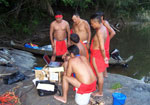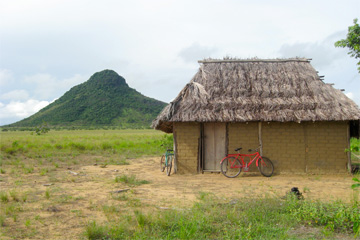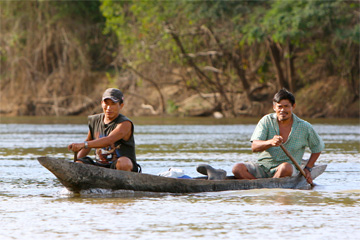New research within the native Wapishana and Makushi communities of
Guyana suggests that indigenous cultural beliefs such as shamanism
help preserve tropical forests and wildlife.
The analysis, published in the September 2010 Journal of Latin
American Geography, draws from a massive data set that tracks wildlife
populations, hunting kill sites, and spiritually significant features
of the landscape within a 48,000-square-kilometer area in southern
Guyana. The authors recruited the hunters themselves to record much of
the data.
The data show that hunters avoid spiritual sites, potentially creating
animal refuges. More than 99 percent of their kills occurred more than
500 meters away from spiritually significant sites.
|
|
The scientists used geographic methods to rule out other influences
over kill locations, such as distances from villages or roads,
vegetation types, and the abundance of food for the hunter’s main
prey: deer, rodents, peccary, and other small mammals.
“These sites are usually considered to be dangerous,” said co-author
Jeff Luzar, a visiting scholar of anthropology at Stanford University,
in an interview with mongabay.com. “Maybe it’s a mountain that has
some kind of story associated with it, or a spring, that people will
avoid.”
Shamans and elders located the spiritual sites on maps of the region
for the scientists, and they recounted the cautionary tales associated
with the sites.
One shaman told the researchers of an angry dragon-like spirit locked
under a mountain just outside the village of Shiriri. The shaman said
earth tremors occurred the one time he climbed the mountain, so
hunters never go there to hunt.
Through the stories they tell, shamans appear to regulate “who goes
hunting, why they go, how long they follow the proscriptions, and how
that influences their diet and hunting practices,” said co-author Jose
Fragoso, a biologist at Stanford University, in an interview with
mongabay.com.
“Shamanism is a fulcrum around which a lot of environmental use is
mediated,” Fragoso said.
The new data should spur more comprehensive studies of hunting and
indigenous resource use, said anthropologist Neil Whitehead of the
University of Wisconsin, who was not part of the research. Whitehead
has studied the Patamuna and other Guyanese indigenous groups.
|
|
“Choices during subsistence hunting are more complex than they first
appear,” Whitehead told mongabay.com. “It incorporates lots of
cultural values.”
The scientists trained dozens of indigenous hunters, usually men, to
conduct wildlife population counts. Intergenerational teams paired
each of the more experienced hunters with a younger hunter. The teams
walked along specially crafted paths in the forest, systematically
recording any animals and animal signs they saw. Collectively, the
hunters have walked more than 25,000 miles (40,000 km) to date,
gathering data.
“We train them in scientific methods of collecting information,
combining the traditional skills of hunters with the ability to record
and think of things in a scientific way,” said Fragoso.
These techniques yield better wildlife population estimates than those
typically gathered by visiting scientists, according to Fragoso. The
counts show that hunting practices in these communities are
sustainable, he stated.
“Because of their societal and cultural rules, their hunting is not as
intense as it could be,” said Fragoso. “They seem not to have caused
any extinctions or major population reductions.”
Added Luzar: “The Wapishana and Makushi seem to be very good stewards
of their resources.”
Citation: Read J, Fragoso J, Silvius K, Luzar J, et al. (2010) Space,
Place, and Hunting Patterns among Indigenous Peoples of the Guyanese
Rupununi Region. Journal of Latin American Geography 9(3): 213-243.
doi: 10.1353/lag.2010.0030
Keith Rozendal is a graduate student in the Science Communication Program at the University of California, Santa Cruz.
Related articles
How rainforest shamans treat disease

(11/10/2009) Ethnobotanists, people who study the relationship between plants and people, have long documented the extensive use of medicinal plants by indigenous shamans in places around the world, including the Amazon. But few have reported on the actual process by which traditional healers diagnose and treat disease. A new paper, published in the Journal of Ethnobiology and Ethnomedicine, moves beyond the cataloging of plant use to examine the diseases and conditions treated in two indigenous villages deep in the rainforests of Suriname. The research, which based on data on more than 20,000 patient visits to traditional clinics over a four-year period, finds that shamans in the Trio tribe have a complex understanding of disease concepts, one that is comparable to Western medical science. Trio medicine men recognize at least 75 distinct disease conditions—ranging from common ailments like fever [këike] to specific and rare medical conditions like Bell’s palsy [ehpijanejan] and distinguish between old (endemic) and new (introduced since contact with the outside world) illnesses. In an interview with mongabay.com, Lead author Christopher Herndon, currently a reproductive medicine physician at the University of California, San Francisco, says the findings are a testament to the under-appreciated healing prowess of indigenous shaman.
An interview a shaman in the Amazon rainforest

(07/28/2008) Deep in the Suriname rainforest, an innovative conservation group is working with indigenous tribes to protect their forest home and culture using traditional knowledge combined with cutting-edge technology. The Amazon Conservation Team (ACT) is partnering with the Trio, an Amerindian group that lives in the remote Suriname-Brazil border area of South America, to develop programs to protect their forest home from illegal gold miners and encroachment, improve village health, and strengthen cultural ties between indigenous youths and elders at a time when such cultures are disappearing even faster than rainforests. In June 2008 mongabay.com visited the community of Kwamalasamutu in Suriname to see ACT’s programs in action. During the visit, Amasina, a Trio shaman who works with ACT, answered some questions about his role as a traditional healer in the village.
 |
Amazon Indians use Google Earth, GPS to protect forest home
(11/14/2006) Deep in the most remote jungles of South America, Amazon Indians are using Google Earth, Global Positioning System (GPS) mapping, and other technologies to protect their fast-dwindling home. Tribes in Suriname, Brazil, and Colombia are combining their traditional knowledge of the rainforest with Western technology to conserve forests and maintain ties to their history and cultural traditions, which include profound knowledge of the forest ecosystem and medicinal plants. Helping them is the Amazon Conservation Team (ACT), a nonprofit organization working with indigenous people to conserve biodiversity, health, and culture in South American rainforests.
Indians are key to rainforest conservation efforts
(10/31/2006) Dr. Mark Plotkin, President of the non-profit Amazon Conservation Team, is partnering with indigenous people to conserve biodiversity, health, and culture in South American rainforests. Plotkin, a renowned ethnobotanist and accomplished author (Tales of a Shaman’s Apprentice, Medicine Quest) who was named one of Time Magazine’s environmental “Hero for the Planet,” has spent parts of the past 25 years living and working with shamans in Latin America. Through his experiences, Plotkin has concluded that conservation and the well-being of indigenous people are intrinsically linked — in forests inhabited by indigenous populations, you can’t have one without the other. Plotkin believes that existing conservation initiatives would be better-served by having more integration between indigenous populations and other forest preservation efforts.
How did rainforest shamans gain their boundless knowledge on medicinal plants?
(5/14/2005) For thousands of years, indigenous people have extensively used rainforest plants for their health needs — the peoples of Southeast Asian forests used 6,500 species, while Northwest Amazonian forest dwellers used 1300 species for medicinal purposes. Perhaps more staggering than their boundless knowledge of medicinal plants, is how shamans and medicinemen could have acquired such knowledge. There are over 100,000 plant species in tropical rainforests around the globe, how did indigenous peoples know what plants to use and combine especially when so many are either poisonous or have no effect when ingested. Many treatments combine a wide variety of completely unrelated innocuous plant ingredients to produce a dramatic effect.

